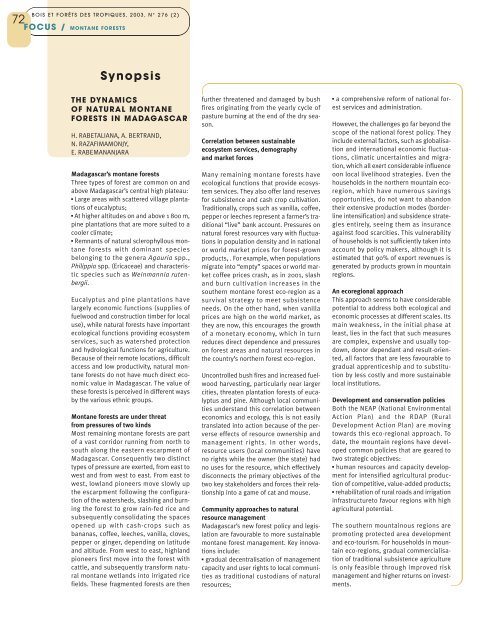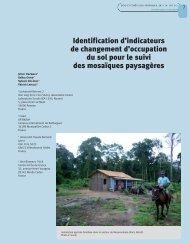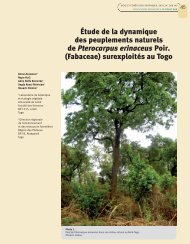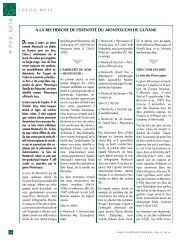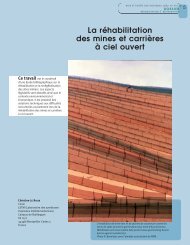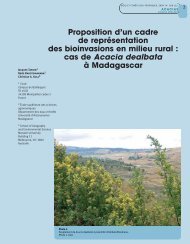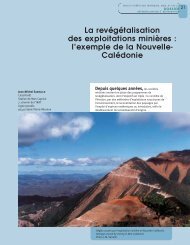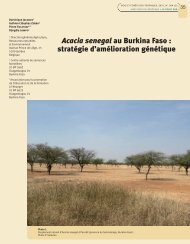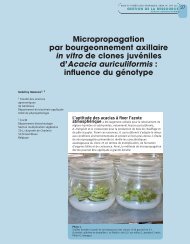Dynamiques des forêts naturelles de montagne à Madagascar
Dynamiques des forêts naturelles de montagne à Madagascar
Dynamiques des forêts naturelles de montagne à Madagascar
- No tags were found...
Create successful ePaper yourself
Turn your PDF publications into a flip-book with our unique Google optimized e-Paper software.
72BOIS ET FORÊTS DES TROPIQUES, 2003, N° 276 (2)FOCUS / MONTANE FORESTSSynopsisTHE DYNAMICSOF NATURAL MONTANEFORESTS IN MADAGASCARH. RABETALIANA, A. BERTRAND,N. RAZAFIMAMONJY,E. RABEMANANJARA<strong>Madagascar</strong>’s montane forestsThree types of forest are common on andabove <strong>Madagascar</strong>’s central high plateau:▪ Large areas with scattered village plantationsof eucalyptus;▪ At higher altitu<strong><strong>de</strong>s</strong> on and above 1 800 m,pine plantations that are more suited to acooler climate;▪ Remnants of natural sclerophyllous montaneforests with dominant speciesbelonging to the genera Agauria spp.,Philippia spp. (Ericaceae) and characteristicspecies such as Weinmannia rutenbergii.Eucalyptus and pine plantations havelargely economic functions (supplies offuelwood and construction timber for localuse), while natural forests have importantecological functions providing ecosystemservices, such as watershed protectionand hydrological functions for agriculture.Because of their remote locations, difficultaccess and low productivity, natural montaneforests do not have much direct economicvalue in <strong>Madagascar</strong>. The value ofthese forests is perceived in different waysby the various ethnic groups.Montane forests are un<strong>de</strong>r threatfrom pressures of two kindsMost remaining montane forests are partof a vast corridor running from north tosouth along the eastern escarpment of<strong>Madagascar</strong>. Consequently two distincttypes of pressure are exerted, from east towest and from west to east. From east towest, lowland pioneers move slowly upthe escarpment following the configurationof the watersheds, slashing and burningthe forest to grow rain-fed rice andsubsequently consolidating the spacesopened up with cash-crops such asbananas, coffee, leeches, vanilla, cloves,pepper or ginger, <strong>de</strong>pending on latitu<strong>de</strong>and altitu<strong>de</strong>. From west to east, highlandpioneers first move into the forest withcattle, and subsequently transform naturalmontane wetlands into irrigated ricefields. These fragmented forests are thenfurther threatened and damaged by bushfires originating from the yearly cycle ofpasture burning at the end of the dry season.Correlation between sustainableecosystem services, <strong>de</strong>mographyand market forcesMany remaining montane forests haveecological functions that provi<strong>de</strong> ecosystemservices. They also offer land reservesfor subsistence and cash crop cultivation.Traditionally, crops such as vanilla, coffee,pepper or leeches represent a farmer’s traditional“live” bank account. Pressures onnatural forest resources vary with fluctuationsin population <strong>de</strong>nsity and in nationalor world market prices for forest-grownproducts, . For example, when populationsmigrate into “empty” spaces or world marketcoffee prices crash, as in 2001, slashand burn cultivation increases in thesouthern montane forest eco-region as asurvival strategy to meet subsistenceneeds. On the other hand, when vanillaprices are high on the world market, asthey are now, this encourages the growthof a monetary economy, which in turnreduces direct <strong>de</strong>pen<strong>de</strong>nce and pressureson forest areas and natural resources inthe country’s northern forest eco-region.Uncontrolled bush fires and increased fuelwoodharvesting, particularly near largercities, threaten plantation forests of eucalyptusand pine. Although local communitiesun<strong>de</strong>rstand this correlation betweeneconomics and ecology, this is not easilytranslated into action because of the perverseeffects of resource ownership andmanagement rights. In other words,resource users (local communities) haveno rights while the owner (the state) hadno uses for the resource, which effectivelydisconnects the primary objectives of thetwo key stakehol<strong>de</strong>rs and forces their relationshipinto a game of cat and mouse.Community approaches to naturalresource management<strong>Madagascar</strong>’s new forest policy and legislationare favourable to more sustainablemontane forest management. Key innovationsinclu<strong>de</strong>:▪ gradual <strong>de</strong>centralisation of managementcapacity and user rights to local communitiesas traditional custodians of naturalresources;▪ a comprehensive reform of national forestservices and administration.However, the challenges go far beyond thescope of the national forest policy. Theyinclu<strong>de</strong> external factors, such as globalisationand international economic fluctuations,climatic uncertainties and migration,which all exert consi<strong>de</strong>rable influenceoon local livelihood strategies. Even thehouseholds in the northern mountain ecoregion,which have numerous savingsopportunities, do not want to abandontheir extensive production mo<strong><strong>de</strong>s</strong> (bor<strong>de</strong>rlineintensification) and subsi<strong>de</strong>nce strategiesentirely, seeing them as insuranceagainst food scarcities. This vulnerabilityof households is not sufficiently taken intoaccount by policy makers, although it isestimated that 90% of export revenues isgenerated by products grown in mountainregions.An ecoregional approachThis approach seems to have consi<strong>de</strong>rablepotential to address both ecological an<strong>de</strong>conomic processes at different scales. Itsmain weakness, in the initial phase atleast, lies in the fact that such measuresare complex, expensive and usually topdown,donor <strong>de</strong>pendant and result-oriented,all factors that are less favourable togradual apprenticeship and to substitutionby less costly and more sustainablelocal institutions.Development and conservation policiesBoth the NEAP (National EnvironmentalAction Plan) and the RDAP (RuralDevelopment Action Plan) are movingtowards this eco-regional approach. Todate, the mountain regions have <strong>de</strong>velopedcommon policies that are geared totwo strategic objectives:▪ human resources and capacity <strong>de</strong>velopmentfor intensified agricultural productionof competitive, value-ad<strong>de</strong>d products;▪ rehabilitation of rural roads and irrigationinfrastructureto favour regions with highagricultural potential.The southern mountainous regions arepromoting protected area <strong>de</strong>velopmentand eco-tourism. For households in mountaineco-regions, gradual commercialisationof traditional subsistence agricultureis only feasible through improved riskmanagement and higher returns on investments.


